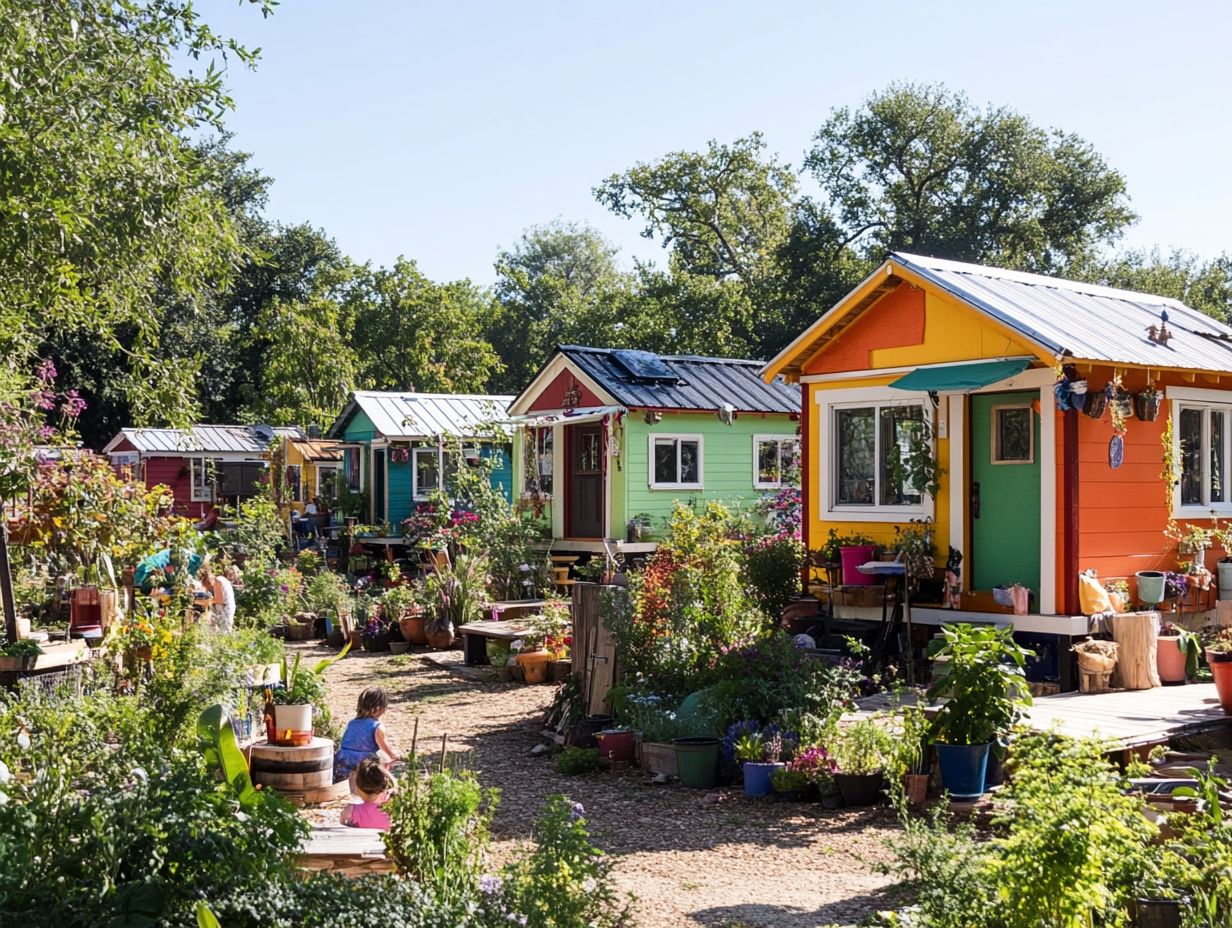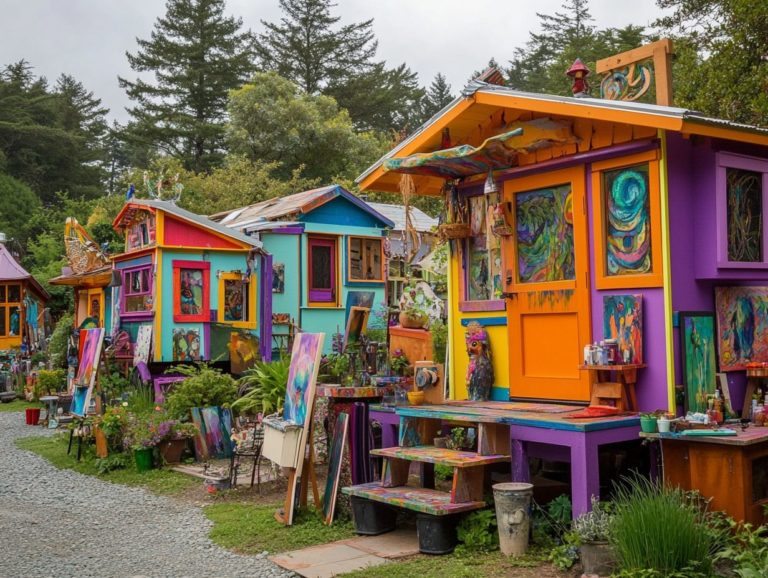Exploring Co-Housing in Tiny House Communities
Co-housing has gained popularity in recent years. It offers a sustainable and enriching living option within tiny house communities.
This article invites you to explore the essence of co-housing while showcasing its numerous benefits, such as shared resources and enhanced community support.
You ll uncover the various types of tiny house communities, delve into potential challenges, and gain practical insights for those considering joining one. Discover how co-housing can elevate your living experience while nurturing meaningful connections with your neighbors!
Contents [hide]
- Key Takeaways:
- The Concept of Co-Housing
- Tiny House Communities
- Benefits of Co-Housing in Tiny House Communities
- Challenges and Considerations
- How to Join a Co-Housing Tiny House Community
- Frequently Asked Questions
- What is co-housing?
- How does co-housing work in tiny house communities?
- What are the benefits of exploring co-housing in tiny house communities?
- Are there any drawbacks to co-housing in tiny house communities, such as those found in the Tiny House Communities across the US?
- How can I find and join a co-housing community in a tiny house community, such as Opportunity Village in Oregon?
- Is co-housing in tiny house communities, including those in the urban rural transect of Arvada, Colorado, a suitable living arrangement for everyone?
Key Takeaways:

- Co-housing promotes a sense of community and shared resources, providing support and reducing living expenses.
- Tiny house communities come in various forms, such as cooperatives and intentional communities, each with unique benefits and considerations.
- To join a co-housing tiny house community, research and connect with existing communities, and consider the challenges and responsibilities that come with shared living.
The Concept of Co-Housing
Co-housing is a new way to live that blends private spaces with communal areas. It fosters a supportive community atmosphere.
This approach champions sustainable living while addressing affordable housing needs, ensuring you have a true sense of home alongside vital community connections.
Frequently emerging in tiny house communities, co-housing harnesses shared resources and group living. This enhances the quality of life for all residents and makes co-housing an attractive option today.
Defining Co-Housing and its Benefits
Co-housing is best understood as a shared living setup that emphasizes community support and shared responsibilities among residents.
This approach nurtures a strong sense of belonging and encourages interactions that enrich your life and the lives of those around you. By pooling resources, you benefit from shared amenities like gardens, kitchens, and recreational spaces, all designed to promote social engagement.
The layout of co-housing inspires residents to come together for group activities, fostering mutual trust and camaraderie.
As a result, you may find your well-being significantly enhanced. The support system within these communities offers both emotional and practical assistance. Ultimately, this lifestyle nurtures a thriving community that prioritizes your personal fulfillment alongside collective achievement.
Tiny House Communities
Tiny house communities present an innovative solution for affordable housing. They offer a unique blend of low-density neighborhoods and ecological mindfulness through mobile tiny houses.
These communities redefine what home means by promoting sustainable living while fostering a sense of belonging among residents.
In this area between urban and rural settings, you ll find an environment that encourages interaction and support, making it an inviting place to call home.
Overview and Types of Tiny House Communities

Tiny house communities, like Emerald Village and Cottage Village in Eugene, Oregon, showcase a variety of living models tailored to diverse lifestyle needs.
These communities encompass everything from eco-friendly villages emphasizing sustainability to urban settings that prioritize convenience and connectivity.
Each community offers distinct structural designs, featuring individual tiny homes, communal facilities, and inviting green spaces that encourage social interaction among residents.
For instance, SquareOne Villages serves as a robust platform for those in search of affordable housing solutions while nurturing a supportive, close-knit environment.
This diversity highlights the range of architectural styles and social frameworks that tiny house living offers, opening up opportunities for community building and shared resources.
Benefits of Co-Housing in Tiny House Communities
Co-housing offers exciting advantages that can transform your living experience! It provides shared resources and strong community support, significantly enhancing your quality of life.
This collaborative living model enables you to efficiently manage common spaces while offering an affordable ownership share. It cultivates an atmosphere of trust, cooperation, and collective responsibility, ensuring that everyone thrives together in this unique setting.
Shared Resources and Community Support
Shared resources, like a shared house and various amenities, are pivotal in enhancing community support within co-housing arrangements.
These communal spaces transcend mere physical structures; they serve as essential hubs for interaction, nurturing connections among residents. Amenities such as shared gardens foster collaboration in gardening, allowing you to work side by side with neighbors, exchange tips, and enjoy the fruits of your labor together.
A communal kitchen encourages you to join cooking classes and potluck dinners, cultivating a sense of camaraderie and shared experience. Libraries and meeting rooms become vibrant venues for workshops and gatherings, where ideas flow freely and friendships deepen.
Through these shared resources, a profound sense of belonging and cooperation flourishes, ultimately enriching the community fabric.
Challenges and Considerations
Co-housing undoubtedly presents a range of advantages, but it also comes with unique challenges that you must navigate to cultivate healthy community relations.
Understanding these challenges is essential for fostering a supportive environment and ensuring the long-term sustainability of the co-housing model within tiny house communities.
Potential Issues and How to Address Them

Potential issues in co-housing, like conflicts among residents and differing priorities, can put the community s harmony and effectiveness at risk.
You need proactive communication and a genuine commitment to understanding diverse perspectives to navigate these challenges. Misunderstandings often arise when residents have contrasting lifestyles or expectations, leading to frustrations that can escalate if left unaddressed.
Establishing regular dialogue through community meetings is crucial, allowing everyone to voice concerns and collaborate on solutions. By encouraging a culture of respect and empathy, you foster strong relationships and reinforce the overall foundation of the co-housing initiative.
Implementing conflict resolution strategies, such as mediation or appointing designated community advocates, can further enhance mutual understanding and create a supportive environment for all residents.
How to Join a Co-Housing Tiny House Community
Joining a co-housing tiny house community requires a series of deliberate steps and careful considerations to ensure you find the perfect match for your lifestyle and values.
Familiarizing yourself with the co-housing model, where residents share spaces and responsibilities, and engaging in community-building initiatives can help you make well-informed choices about your future living arrangements.
Take the first step towards your dream lifestyle in a co-housing tiny house community today!
Steps and Tips for Finding and Joining a Community
Finding your co-housing community can be an exciting journey! It involves careful planning and thorough research to ensure it fits your lifestyle.
Begin by pinpointing the specific features or amenities essential for your daily living, such as communal gardens, shared resources, or accessibility options. Utilize online platforms focused on co-housing networks; these are invaluable for exploring listings and engaging in conversations with current members. Additionally, consider the importance of sustainability in tiny house communities when making your choices.
Attend local meetups or workshops to network and glean insights from individuals who have already navigated this path. Visit potential communities in person to get a clear sense of the environment and the dynamics among residents.
Remember, fostering successful relationships within these communities relies on open communication, active participation in group activities, and mutual respect for shared spaces. This approach will ensure a harmonious and enriching co-housing experience for you.
Frequently Asked Questions
What is co-housing?

Co-housing is a type of intentional community where residents live in separate dwellings but share common spaces and facilities, such as a kitchen or living area.
How does co-housing work in tiny house communities?
In co-housing within tiny house communities, residents have their own individual tiny houses but share common spaces and facilities with their neighbors, promoting a sense of community and collaboration.
What are the benefits of exploring co-housing in tiny house communities?
Some benefits include a lower cost of living, reduced environmental impact, and a stronger sense of community and social support.
Are there any drawbacks to co-housing in tiny house communities, such as those found in the Tiny House Communities across the US?
One potential drawback is the lack of privacy, as residents share common spaces with their neighbors. There may also be challenges in coordinating and managing shared resources and responsibilities.
How can I find and join a co-housing community in a tiny house community, such as Opportunity Village in Oregon?
You can research and reach out to existing co-housing communities in tiny house communities, or join online forums and groups to connect with like-minded individuals and start your own co-housing project.
Is co-housing in tiny house communities, including those in the urban rural transect of Arvada, Colorado, a suitable living arrangement for everyone?
Co-housing in tiny house communities may not be suitable for everyone, as it requires a certain level of compromise and willingness to live in close proximity with others. However, it can be a fulfilling and enriching experience for those who value community and shared living.






